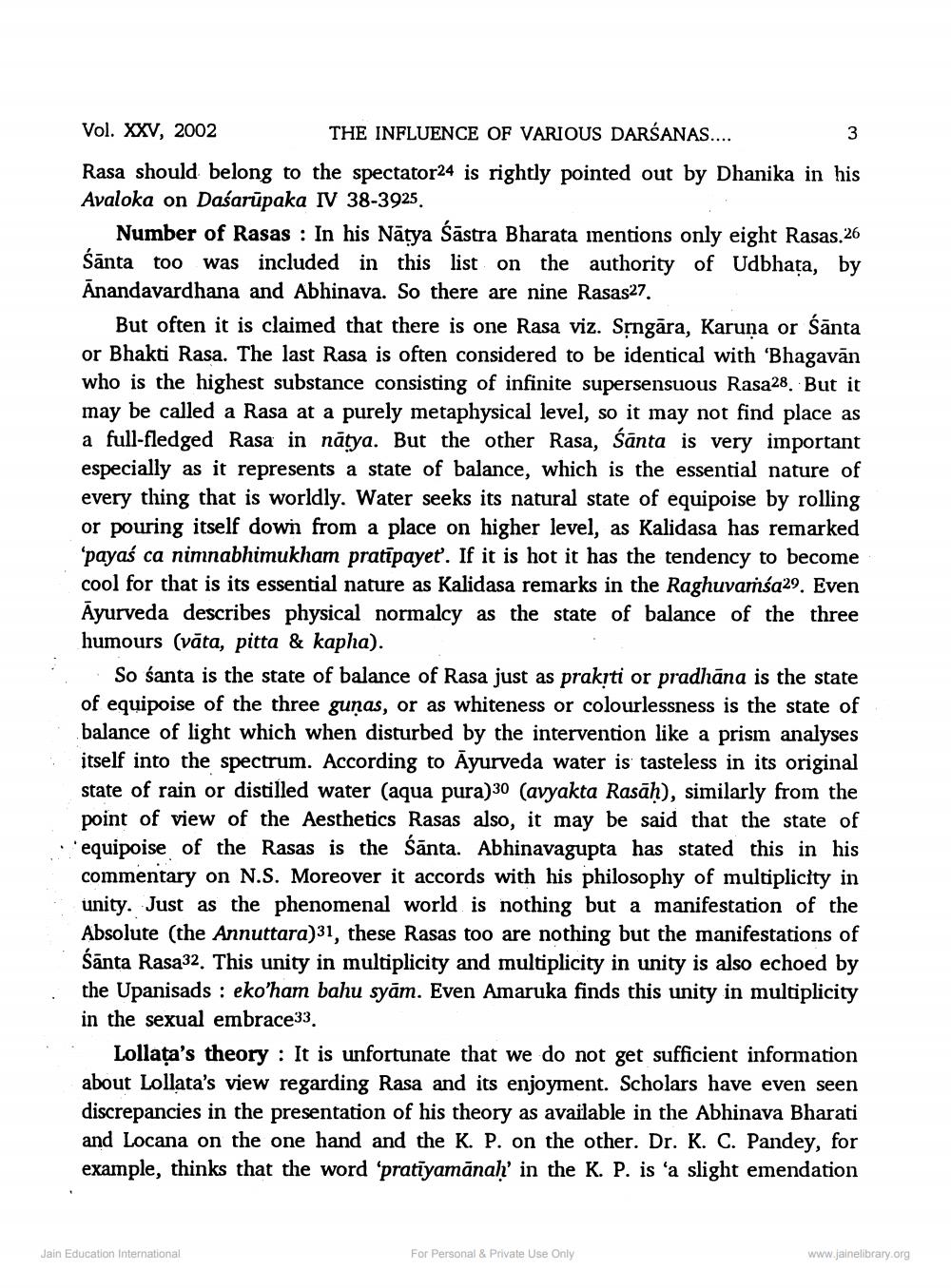Book Title: Sambodhi 2002 Vol 25 Author(s): Jitendra B Shah, N M Kansara Publisher: L D Indology Ahmedabad View full book textPage 8
________________ Vol. XXV, 2002 THE INFLUENCE OF VARIOUS DARśANAS.... Rasa should belong to the spectator24 is rightly pointed out by Dhanika in his Avaloka on Dasarūpaka IV 38-3925. Number of Rasas : In his Nātya Śāstra Bharata mentions only eight Rasas.26 śānta too was included in this list on the authority of Udbhata, by Anandavardhana and Abhinava. So there are nine Rasas27 But often it is claimed that there is one Rasa viz. Srngāra, Karuna or śānta or Bhakti Rasa. The last Rasa is often considered to be identical with 'Bhagavān who is the highest substance consisting of infinite supersensuous Rasa28. But it may be called a Rasa at a purely metaphysical level, so it may not find place as a full-fledged Rasa in nātya. But the other Rasa, śānta is very important especially as it represents a state of balance, which is the essential nature of every thing that is worldly. Water seeks its natural state of equipoise by rolling or pouring itself down from a place on higher level, as Kalidasa has remarked 'payaś ca nimnabhimukham pratīpayeť. If it is hot it has the tendency to become cool for that is its essential nature as Kalidasa remarks in the Raghuvaṁsa29. Even Ayurveda describes physical normalcy as the state of balance of the three humours (vāta, pitta & kapha). So santa is the state of balance of Rasa just as prakrti or pradhāna is the state of equipoise of the three gunas, or as whiteness or colourlessness is the state of balance of light which when disturbed by the intervention like a prism analyses itself into the spectrum. According to Ayurveda water is tasteless in its original state of rain or distilled water (aqua pura)30 (avyakta Rasāh), similarly from the point of view of the Aesthetics Rasas also, it may be said that the state of 'equipoise of the Rasas is the śānta. Abhinavagupta has stated this in his commentary on N.S. Moreover it accords with his philosophy of multiplicity in unity. Just as the phenomenal world is nothing but a manifestation of the Absolute (the Annuttara)31, these Rasas too are nothing but the manifestations of śānta Rasa32. This unity in multiplicity and multiplicity in unity is also echoed by the Upanisads : eko'ham bahu syām. Even Amaruka finds this unity in multiplicity in the sexual embrace33. Lollata's theory : It is unfortunate that we do not get sufficient information about Lollata's view regarding Rasa and its enjoyment. Scholars have even seen discrepancies in the presentation of his theory as available in the Abhinava Bharati and Locana on the one hand and the K. P. on the other. Dr. K. C. Pandey, for example, thinks that the word 'pratīyamanah' in the K. P. is 'a slight emendation Jain Education International For Personal & Private Use Only www.jainelibrary.orgPage Navigation
1 ... 6 7 8 9 10 11 12 13 14 15 16 17 18 19 20 21 22 23 24 25 26 27 28 29 30 31 32 33 34 35 36 37 38 39 40 41 42 43 44 45 46 47 48 49 50 51 52 53 54 55 56 57 58 59 60 61 62 63 64 65 66 67 68 69 70 71 72 73 74 75 76 77 78 79 80 81 82 ... 234
